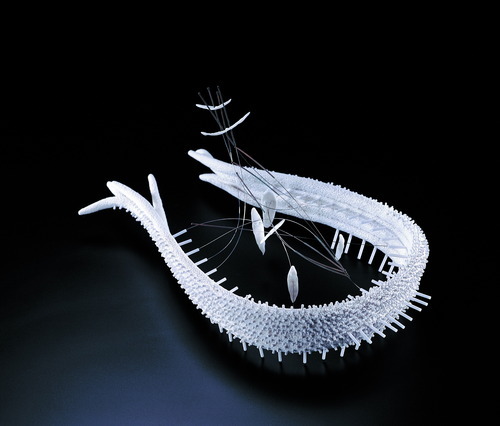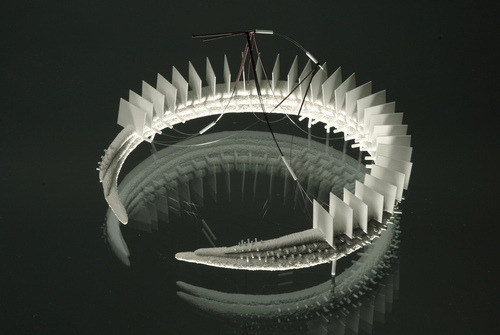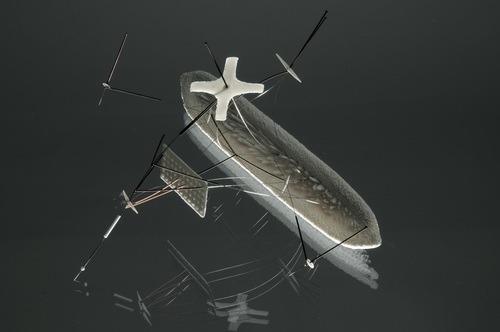
You take your inspiration from nature. You are not just making a superficial observation, but you conduct a research on the things hidden to the naked eye. Tell us more about the universe you have discovered through your explorations.
I am fascinated by the natural world in its widest sense and at all levels. An interest in the nature of time – the past, present and future has led me to investigate multiverse theory and hidden dimensions – concealed worlds. From there I began to examine nature on a microscopic and nanoscale. I became fascinated with the concept of the unseen.
One of the subjects I investigated was that of diatoms, especially fossil diatoms. Invisible to the naked eye, beautiful and structurally complex I discovered them to be very significant to the field of paleoclimatology – they are an important indicator of climate change.
I like to select various aspects of the natural world and then examine them on both a macroscopic and microscopic level, considering them in terms of their relationship to time and how they relate to other parts of the universe.
Intricate but also delicate, your work seems to be obtained through a very meticulous process. What materials and techniques do you use and how much time does it take to complete a new piece?
Porcelain is the clay I favor – I particularly like ‘Southern Ice White’ which was developed by the Australian ceramicist Les Blakebrough. In general, the works are handbuilt; occasionally I use slip in a free but controlled way, sometimes combining it with fine glass fibre. I like to push the material beyond its perceived boundaries. The characteristics of porcelain mean that it requires careful handling throughout the making process and control and accuracy with firing and cooling.
I often incorporate extraneous materials once the piece is fired such as metal, monofilament, fibre or horsehair. These elements add richness to the work.
A new piece can take up to two weeks to make, depending on its complexity, and it can take a further week or two to construct and apply other elements. I work intuitively when I am making, drawing on my research and bringing all the experiences together.

Annie Woodford, Circlet, 2009, Porcelain, copper, stainless steel, 24 x 24 x 24 cm
Both science and art are a way of looking at the surrounding environment. What do you think is their meeting point? What kind of form of knowledge is art?
I often find myself working with scientists on projects, and I think the two disciplines have many aspects in common. They both help us to understand the world around us. They both rely on investigation and imagination – the ‘what if?’ principle.
Using creativity to think in a different way about an abstract theory or problem can be a catalyst for discoveries in both art and science. Some of the best artists engage with science, they look at life and the world around them in an analytical way and then integrate that within intuitive way of working. For me, the sublime goal is to combine intellect with intuition. Above all artists can help scientists to look at things differently and vice versa.
Tell us about ‘Beyond the Surface of Things’, your research project conducted in Iceland.
In 2006, I received a research award for a project that required investigating the interface between macro and micro. Iceland was a country I was familiar with, and its environment seemed the perfect location to explore that particular concept.
Here is a short report, which describes the project.
‘Iceland is a land of breath-taking beauty. Unspoilt, the silent, brooding landscape conceals the raw power of nature, both above and beneath its fragile shifting crust. Horizons merge into the sky, and the empty fractured vistas contain a dream-like quality, all of it enveloped in the purest, cleanest air. Possessing a magic, invisible – but there -, to cross it is like plunging into an unknown mysterious passage, uncontaminated by man, into a timeless shadowy world.
It was twenty-eight years ago that I made my first visit to Iceland. Instantly captivated by the desolate lava deserts, punctuated by luminous rhyolite mountains and adorned with immense glaciers, it has become my favourite place on Earth.
The purpose of my visit this year was to carry out research for the project Beneath the Surface of Things. For a long time I have been interested in hidden worlds, those places we cannot see, ever present, existing beyond our vision; beyond our dimension. Reveal the concealed, and the unseen is seen. Once seen, does it become real, or was it always so?
In June 2006, I travelled once again into the empty Southern Highlands towards Vatnajokull and Landmannalaugar, to the black sands of Vik and the stunning Snaefellsnes Peninsula, its glacier dominating the view for miles. Then to Geysir, where the mud pools and striking siliceous sinter formations provided rich material for the study.
Using a variety of media and equipment, including a portable x100 digital microscope linked to an Apple laptop and using precise map coordinates, I documented specific areas of landscape, taking images and readings. Drawings, video, photographs of the place captured the distant view; detailed drawings, macro photos of the site – the closer view; finally microscopic readings of the surface the inner view, beyond the surface. By adding satellite imagery (courtesy of NASA) 3D becomes 2D, 2D becomes 3D and in effect macro becomes micro, micro becomes macro.
The collected data and images will ultimately result in a large-scale installation. The aim is to reflect the haunting atmosphere while revealing layer upon layer of shifting, subtle happenings and the conflict between inner and outer forces. Those things we cannot see are often the most powerful and disturbing.

Annie Woodford, Splinter 2, Porcelain, copper, stainless steel, 30 x 25 x 30 cm.
You are currently involved in a number of projects. Please share some of them with us. Where can we see your work in the future?
The ‘Surface’ project is printmaking and artists’ books collaboration with the artist Frances Kiernan.This will culminate in an exhibition and short film.Also I am in the process of developing a multi media research project about diatoms and radiolarian using the collections housed in The Academy of Natural Sciences, Philadelphia. This will take place in 2013.
Later this year my work is included in a printmaking exhibition at Kyoto Museum, Japan. There will be a film made in 2013 about my work, describing concepts, themes and making processes.
We have recently moved from London to Edinburgh, Scotland and are having a house with studiosbuilt in Highland Perthshire so much of my time this year and next will be spent is organizing that project.
By Ileana Surducan and Vasi Hirdo. The full interview was published in Ceramics Now Magazine, Issue 2.
Visit Annie Woodford’s website.
View the list of interviews with ceramic artists.



















